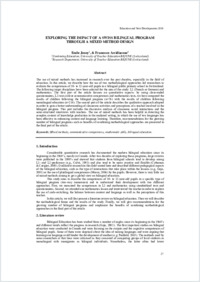Exploring the impact of a Swiss bilingual program through a mixed method design
Haute École Pédagogique BEJUNE
- Jenny, Emile ORCID Haute École Pédagogique BEJUNE
- Arcidiacono, Francesco ORCID Haute École Pédagogique BEJUNE
- 2019
Published in:
- Education and New Developments 2019. Vol. II / Carmo, Mafalda. - 2019, p. 27-31
English
The use of mixed methods has increased in research over the past decades, especially in the field of education. In this article, we describe how the use of two methodological approaches led researchers to evaluate the competences of 10- to 12-year-old pupils in a bilingual public primary school in Switzerland. The following target disciplines have been selected for the aim of the study: L2 (French or German) and mathematics. The first part of the article focuses on quantitative aspects: by using close-ended questionnaires, L2-tests in four communicative competences and mathematics tests, we have compared the results of children following the bilingual program (n=76) with the results of children following monolingual education (n=214). The second part of the article describes the qualitative approach adopted in order to gain a better understanding of classroom activities and perceptions of a teacher involved in the bilingual program. This part includes the discursive analysis of class room social interactions and the semi-structured interviews with teachers. The use of mixed methods has been helpful in detecting the complex context of knowledge production in the analyzed setting, in which the use of two languages has been effective in enhancing content and language learning. Therefore, recommendations for the growing number of bilingual programs such as benefits of combining methodological approaches are presented in the final part of the article.
- Language
-
- English
- License
- Open access status
- gold
- Identifiers
-
- DOI 10.36315/2019v2end006
- ISBN 9789895431250
- Persistent URL
- https://sonar.ch/global/documents/312248
Statistics
Document views: 70
File downloads:
- Education-and-New-Developments_2019_Vol_II.pdf: 168
